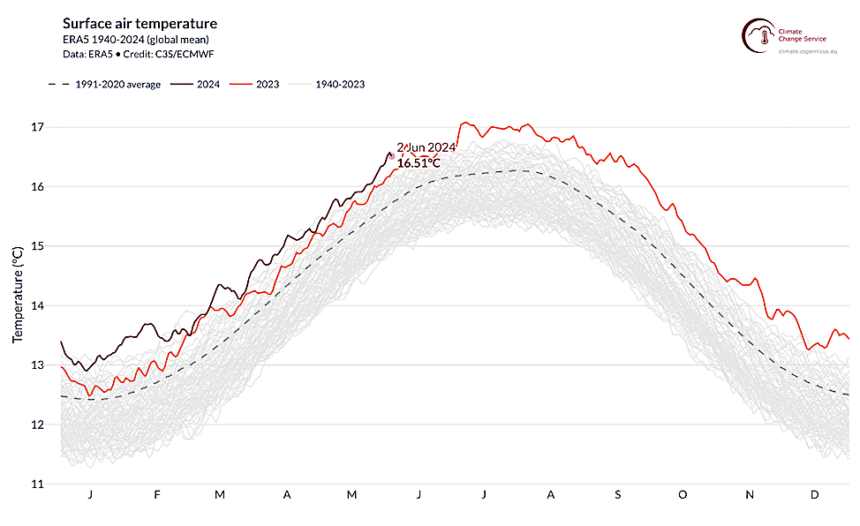Yves here. The generally scary heat levels of this year are set to abate a bit. But a break in trends should not be mistaken for much of a change in trajectory.
By Bob Henson, a meteorologist and journalist based in Boulder, Colorado. He has written on weather and climate for the National Center for Atmospheric Research, Weather Underground, and many freelance venues. Bob is the author of “The Thinking Person’s Guide to Climate Change” and of “The Rough Guide to Climate Change,” a forerunner to it, and of “Weather on the Air: A History of Broadcast Meteorology”, and coauthor of the introductory textbook “Meteorology Today”. For five years and until the summer of 2020 he co-produced the Category 6 news site for Weather Underground. Originally published at Yale Climate Connections
f you’ve got a chronic health concern and you suddenly get acutely sick, you and your doctors face two big issues: what’s behind your short-term crisis, and what are the implications for your longer-term health?
Our world’s “planet doctors” have been at a similar stress point for close to a year now. They’ve been scrambling to figure out why Earth’s surface – including both atmosphere and oceans – got hit with an unprecedented spike of heat that’s run from mid-2023 well into 2024. They’ve also been addressing what, if anything, the spike tells us about the next few years and beyond.
Several fresh papers are out on two unique and much-publicized factors that may have influenced the astounding global heat of 2023-24. There’s much more coming down the research pike: for example, five journals within the Nature umbrella are joining forces for a special cross-journal issue that will focus on the spike. As the submission invitationput it, “It is not yet clear what caused the various climatic anomalies in 2023, but the answers will shape our understanding of what is to come – whether 2023 was a singular outlier year, or if it is a new baseline from which warming will continue to new levels.”
The planet’s immediate fever hasn’t yet broken. Looking at the global-scale averages calculated daily by the Copernicus Climate Change Service, surface air temperatures have set records on dozens of dates since mid-2023, and sea surface temperatures have set records each day for more than a solid year (see Figures 1 and 2 below).
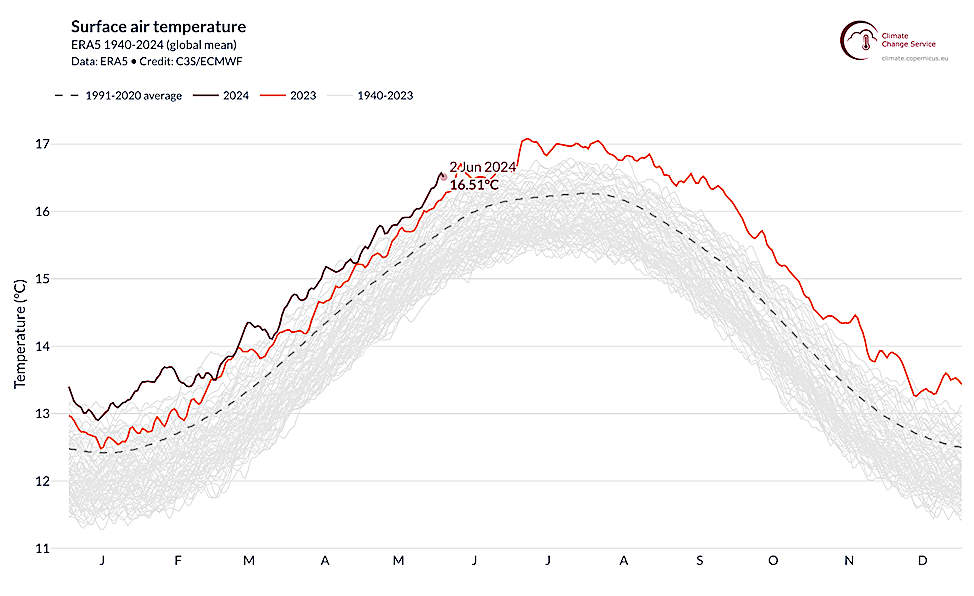
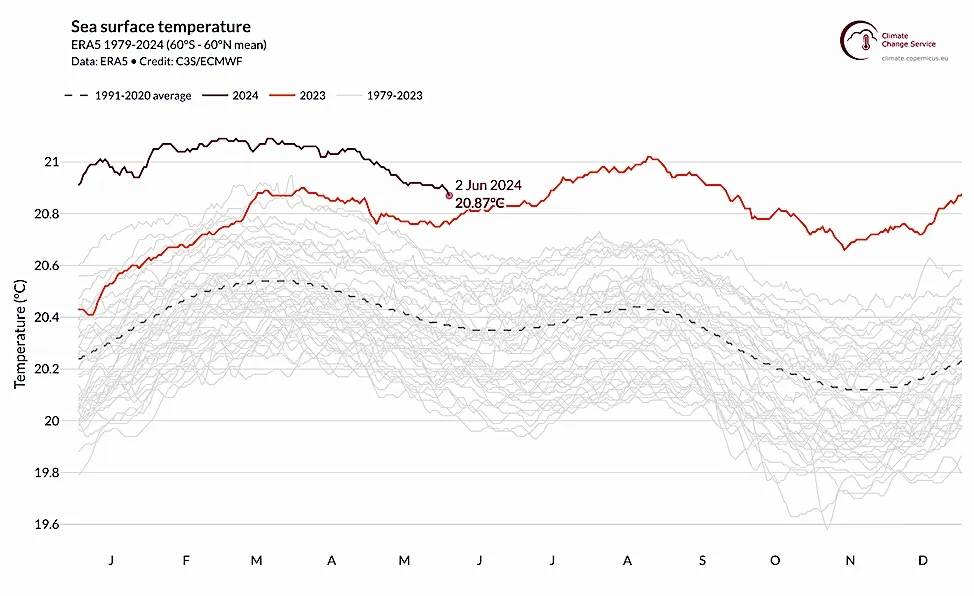
As catalogued here in monthly posts by Jeff Masters, every month since June 2023 has been the warmest globally in observations and analyses going back to 1850. This month NOAA and NASA will likely concur with the Copernicus Climate Change Service that May 2024 set yet another global monthly heat record.
In a special address on Wednesday (World Environment Day) titled “A Moment of Truth”, UN Secretary General António Guterres referred to the latest Copernicus data as well as a new report from the World Meteorological Organization. The WMO gave a 47% chance that the period 2024-2028 will average at least 1.5°C above preindustrial levels, and an 86% chance that at least one year in that period will set a new yearly global record, beating out 2023.
May 2024 was the hottest May in history, marking 12 straight months of hottest months ever.
Our planet is telling us something, but we don’t seem to be listening.
It’s time to mobilise, act & deliver.
It’s #ClimateAction crunch time. pic.twitter.com/7IIy5mJaxg
— António Guterres (@antonioguterres) June 5, 2024
In April alone, 34 locations set all-time monthly highs for their respective nations and territories. And in May and early June, many populous tropical and subtropical locations from India to southeast Asia to Mexico have endured miserable, dangerous heat at or or near all-time records.
Even satellite-based lower-atmosphere temperature data – long used as ammunition by those who would dismiss or deny long-term warming – haven’t escaped the intense spike.
Global warming has stopped! The pause has begun!
NO WARMING SINCE APRIL 2024! pic.twitter.com/q1FQCGyckJ
— Andrew Dessler (@AndrewDessler) June 4, 2024
The handwriting does appear to be on the wall for the demise of the 2023-24 heat spike, mainly because the Pacific is rapidly transitioning toward La Niña. The upwelling caused by La Niña typically brings immense volumes of deeper, cooler water to the surface of the eastern tropical Pacific, spanning an area that can sprawl larger than the United States. We can expect that cool infusion to bring down globally averaged air and ocean temperatures by a few tenths of a degree Fahrenheit for at least a few months. That should be enough to end the current string of daily global records and near-records, perhaps as soon as July.
It may take a lot longer to fully understand what’s happened in the last year, and what it may portend for our future.
🌡️ El Niño peaked in December 2023 as one of the five strongest on record.
🌀Because of the extra heat and moisture in our atmosphere, our weather will continue to be more extreme.
🌐 #EarlyWarningsForAll initiative remains WMO’s top priority. https://t.co/13qHHwNYDW pic.twitter.com/tmjAiwJ3Dy
— World Meteorological Organization (@WMO) June 4, 2024
Ships, Smokestacks, and Sunlight
It should go without saying that the 2023-24 heat spike arose on top of relentless long-term warming, caused by the greenhouse gases pumped out as fossil fuels get burned. Global temperatures simply couldn’t have hit such a peak without a century-plus of global heating bolstering the spike.
The next biggest factor was the El Niño event of 2023-24, the strongest since 2015-16 and one of the two strongest of the 21st century thus far. In contrast to La Niña, the oceanic warmth slathered across the eastern tropical Pacific by El Niño typically raises global surface air temperature by several tenths of a degree Fahrenheit.
In fact, Michael Mann (University of Pennsylvania) and others have argued that much like the El Niño heat peak of 2015-16, the 2023-24 values fall within the margin of natural variability around the longer-term warming trend.
Still, there was a hefty difference of around 0.24 degree Celsius or 0.43 degrees Fahrenheit between the 2015-16 and 2023-24 peaks (based on May-to-April data from NOAA, as shown in Fig. 3 below). And questions remain: exactly how did natural variability, and/or something more, manage to produce such a jump from one strong El Niño event to the next? And why was September 2023 in particular such a record-destroyer?
It’s when you drill down past long-term warming and El Niño that the science saga gets more intriguing and more contentious.
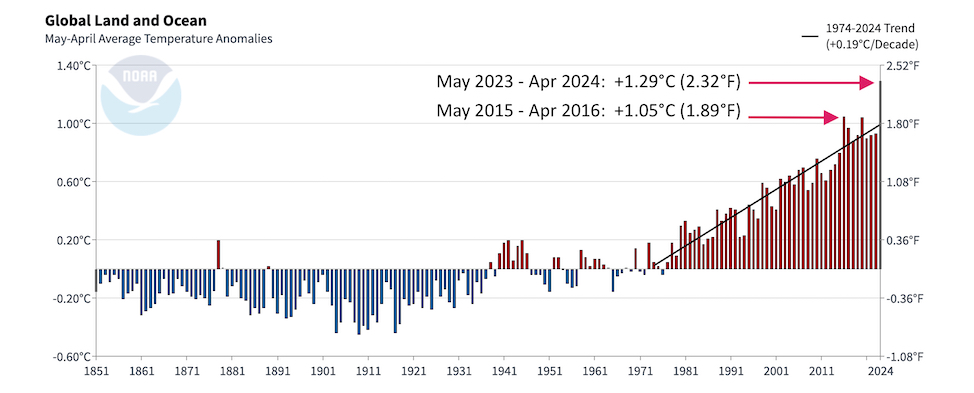
One of the often-cited secondary factors at work is a sharp drop in the sulfate aerosol emissions spewed out from global shipping. That decline was triggered by regulations put into effect by the International Maritime Organization in 2020. They reduced sulfate emissions from shipping by some 70% and global sulfate emissions by roughly 10%.
The direct effect – fewer sun-blocking aerosols and thus more sunlight reaching Earth’s surface – is fairly straightforward. Changes in sulfates also have indirect effects: the presence of aerosols can shift the numbers and size distribution of cloud droplets, which in turn affects how much sunlight reaches Earth’s surface.
Taking both processes into account, a 2023 analysis by Carbon Brief estimated that global temperatures will be about 0.05 degrees Celsius warmer than otherwise expected by 2050 as a result of the 2020 sulfate emission cuts – in effect, speeding up global warming by about two years.
That may seem like a mere drop in the climate-change bucket. But the influx of energy has been greatest along oceanic shipping lanes – including, importantly, those across the North Atlantic, the spawning ground for U.S. Gulf and Atlantic hurricanes. Sea surface temperatures across the North Atlantic have been smashing records over most of the past year. They’re now at unprecedented heights for the start of hurricane season, as discussed here by Michael Lowry in a May 22 post.
The sea surface temperature averaged over the North Atlantic has now been record-warm for 15 consecutive months. One does start to wonder how or when it stops breaking its own records every month and year… this is not normal. pic.twitter.com/BbLPS7U43Y
— Brian McNoldy (@BMcNoldy) June 4, 2024
A new paper in Communications Earth and Environment led by Tianle Yuan (GESTAR-II/University of Maryland) estimates that the increased solar input from the drop in sulfates – which the paper calls an “inadvertent geoengineering termination shock” – could lead to a doubled rate of global warming in the 2020s compared to the last half-century. The new energy balance estimates from the Yuan paper are roughly consistent with earlier studies, but there’s been some pushback on technical grounds in the paper’s extrapolation from energy balance to global temperature trends.
“This is a timely study, but it makes very bold statements about temperature changes and geoengineering which seem difficult to justify on the basis of the evidence,” said Dr. Laura Wilcox, associate professor at the UK’s National Centre for Atmospheric Science in the University of Reading, in a roundup of reactions at Science Media Centre.
Update (June 5): Another new paper – still in preprint form at EGUSphere, and not yet peer-reviewed – describes CESM ensemble simulations that incorporate a 90% drop in sulfate emissions from shipping in 2020, and produce a delayed global-warming spike in 2023 not unlike the one actually observed.
Three new papers just added to the ongoing research surrounding the role of 2020 reduction in shipping sulfates on the recent spike in global temperatures – two suggest minor contributions while @danvisioni and colleagues find a more substantial warming. Science in action! https://t.co/Tx1LdwfDia
— Michael Lowry (@MichaelRLowry) June 5, 2024
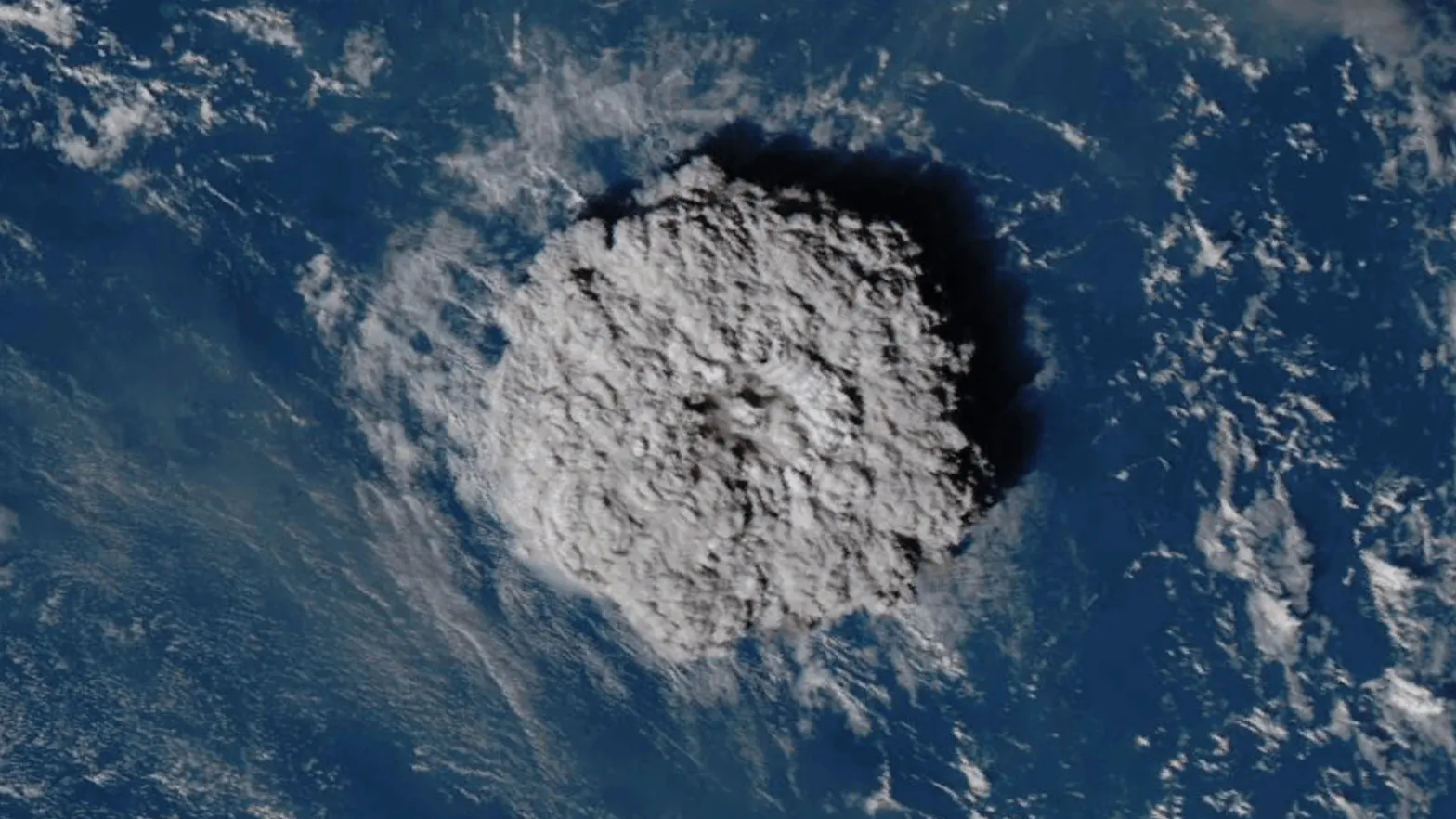
What About That Undersea Volcano?
The eruption of the Hunga Tonga–Hunga Haʻapai volcano in the Southwest Pacific on January 15, 2022, grabbed the attention of vulcanologists and climate scientists worldwide. The eruption was the most powerful since that of Mount Pinatubo in the Philippines in 1991.
The immense blast from Pinatubo spewed enough sulfates into the stratosphere to bring down global temperatures by as much as 0.6 Celsius (1 degree Fahrenheit) over the next year-plus. The new wrinkle with the latest eruption: Hunga Tonga is located beneath the Southwest Pacific, rather than atop an island. The eruption ended up pushing less sulfur dioxide than Pinatubo into the atmosphere, but it added a massive infusion of water vapor, enough to boost the total amount of stratospheric moisture by as much as 10 percent. The added water vapor has since worked its way to higher latitudes within the stratosphere.
As with other greenhouse gases at high altitudes, the radiative effects of the water vapor added by Hunga Tonga have been to cool the stratosphere while slightly warming Earth’s surface. A couple of early estimates were that the eruption’s sulfates led to around 0.004°C of global cooling in 2022, and that the water vapor would lead to as much as 0.035°C of global warming over five years, perhaps accounting for a minor slice of the recent global heat spike.
A paper in review at ESS Open Archive led by Mark Schoeberl (Science and Technology Corporation) estimates that the net effect from both water vapor and sulfate aerosols from Hunga Tonga has actually been a tiny cooling of Earth’s surface, and that the combined radiative effects were nearly gone by the end of 2023. The study does not evaluate conditions above 35 km in the stratosphere, where water vapor remains roughly 10 to 20 percent more prevalent than before the eruption, as the effects on climate from water vapor at such high altitudes have been considered negligible.
The transition to higher altitude is particularly pronounced.
It’s plausible, e.g. Solomon et al. 2010, that this greatly reduces the climate impact of this water vapor, but I also wonder how well we really understand these changes, which have essentially never been seen before. pic.twitter.com/EVAZA3u3Z7
— Dr. Robert Rohde (@RARohde) May 7, 2024
Another recent paper, this one just published in the Journal of Climate, asserts that we could see a complex web of regional weather and climate effects for years to come as a result of Hunga Tonga’s water vapor. Led by Martin Jucker (University of New South Wales), the paper uses the WACCM global climate model, which incorporates stratospheric chemistry, to simulate a Hunga Tonga-like eruption and its impacts up to a decade out.
The study’s estimate of global warming from the added water vapor was a mere 0.015 degrees Celsius. What’s much more striking is a projected reshuffling of weather patterns over the latter half of the 2020s, apparently caused by interacting circulation changes and cloud feedbacks. If this new study’s projections end up on target, winter warming across the northern high latitudes (including the Arctic) and springtime warming across much of Eurasia could intensify, while Australian winters could be cooler and wetter than average, all else being equal. There are also hints of El Niño conditions being favored in the tropical Pacific.
Discussing these and other “surprising, lasting impacts” in an essay for The Conversation, Jucker added: “…we hope that our study will stir scientific interest to try and understand what such a large amount of water vapor in the stratosphere might mean for our climate.”
Yet another (but very minor) factor is the timing of the ongoing peak in the 11-year solar cycle. Variations in solar heat energy across the cycle are minimal (less than 1%) compared to the forcing from greenhouse gases, and the ups and downs of the cycle don’t affect our long-term warming trajectory. Still, the sun is now approaching the peak of Solar Cycle 25, spitting out active regions (and triggering a spectacular auroral display in May), so there may be a tiny, temporary dollop of extra solar energy in the mix right now. This cycle has been more active than predicted, even if it’s still among the weakest of the last 200 years.
The Main Headline Hasn’t Changed
For all the cool science it’s generating, the 2023-24 heat spike is first and foremost a danger sign. Even assuming that globally averaged air and sea temperatures manage to drop a bit below record levels for the next one to several years – something that’s quite possible, perhaps even likely – the spike has given us a preview of what might become “normal” as soon as the 2030s, as greenhouse gases from human activity continue to accumulate in the atmosphere. That accumulation will continue even when global emissions level out and begin to drop, as may happen over the next several years. Only when emissions drop to near zero will the accumulation cease.
Given how strange the spike has been, it’s wise not to assume too much about its demise just yet. One of the most ominous recent takes is from eminent NASA climate scientist James Hansen, who asserted with coauthors in a 2023 Oxford Open Climate Change paper, Global Warming in the Pipeline, that declining global aerosol emissions (including the cuts triggered by the new shipping regulations) will accelerate the planetary warming rate well beyond standard projections.
Zeke Hausfather offered a counterpoint in a Carbon Brief post on April 4, stressing that some acceleration in warming has long been projected by models and that the 2023-24 spike may not signal anything unusual: “There is a risk of conflating shorter-term climate variability with longer-term changes – a pitfall that the climate science community has encountered before.”
An ongoing thread launched with a RealClimate post on May 30 is highlighting new research and data points related to the 2023 extremes. Post author Gavin Schmidt, who succeeded Hansen as director of NASA’s Goddard Institute for Space Studies, also penned a commentary in Nature on March 19 entitled Climate models can’t explain 2023’s huge heat anomaly — we could be in uncharted territory. In that writeup, Schmidt stressed:
…the 2023 temperature anomaly has come out of the blue, revealing an unprecedented knowledge gap perhaps for the first time since about 40 years ago, when satellite data began offering modelers an unparalleled, real-time view of Earth’s climate system. If the anomaly does not stabilize by August — a reasonable expectation based on previous El Niño events — then the world will be in uncharted territory.”
Jeff Masters contributed to this post.

